5 Choking Prevention Tips with Brandon Doerksen
- Ways to reduce choking risks as a baby takes the transition to solid foods while baby-led weaning
- Courses for parents to educate themselves on how to react if their baby chokes
- The difference between a choke and a gag and the importance of observing a baby during the early stages of eating

LISTEN TO THIS EPISODE
Episode Description
Is choking serious business? Of course it is! Although rare, choking is a real risk and a primary concern for all parents when starting their baby on solids. To help ease this anxiety, I am joined by Brandon Doerksen who is the founder of Thrive Training Institute which is an online CPR program aiming to help parents gain knowledge and confidence in case they encounter a choking baby. Brandon will be reviewing five choking prevention tips on how to reduce the risk of choking in babies while baby-led weaning.
About the Guest
- Brandon Doersken and his wife Caitlyn are co-founders of Thrive Training Institute which is an online training platform that specializes in health and safety training
- Thrive Training Institute offers courses that include CPR, first aid, refresher CPR bundle and the choking prevention & response course

Links from This Episode
CPR COURSE
- CPR skills save babies’ lives. BLW does not increase choking risk but knowing CPR can save your baby’s life in the event of choking. SIGN UP for the CPR Course at THRIVE TRAINING INSTITUTE you can get $10 off with my affiliate discount code KATIE10.
CHOCKING PREVENTION & RESPONSE COURSE
- The course is a comprehensive choking prevention curriculum that I teach along with Dawn Winkelmann, MS, CCC-SLP and Brandon Doerksen, CPR Trainer. You can use the code KATIE10 to get $10 off.
- Baby-Led Weaning with Katie Ferraro program with the 100 First Foods™ Daily Meal Plan, join here: https://babyledweaning.co/program
- Baby-Led Weaning for Beginners free online workshop with 100 First Foods™ list to all attendees, register here: https://babyledweaning.co/baby-led-weaning-for-beginners

Latest Episodes
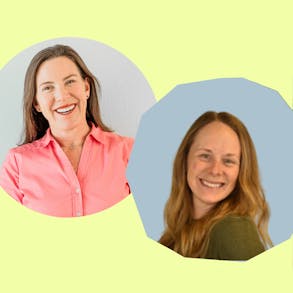
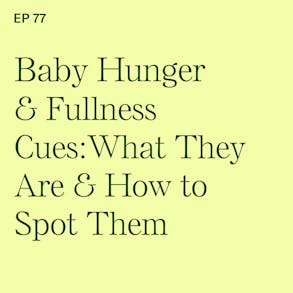
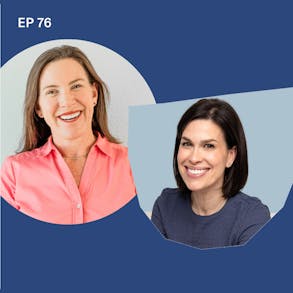
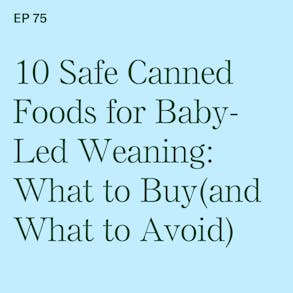
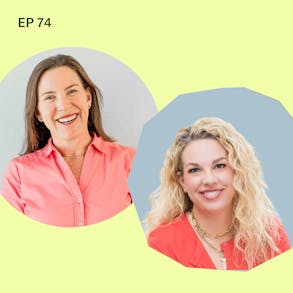
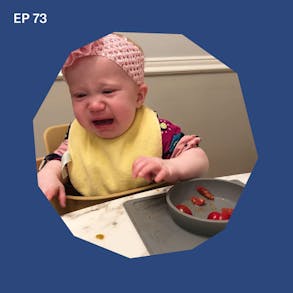
Brandon Doerksen (1m 2s):
So number one, CPR refresher course, number two, making your home a safe place. Getting those toking items out. Number three, waiting until they're ready. Number four, proper highchair positioning and number five. We're going to talk about safe food preparation.
Katie Ferraro (1m 17s):
I'm Katie Ferraro, registered dietitian, college nutrition professor and mom of seven specializing in baby led weaning here on the baby led weaning made easy podcast. I help you strip out all of the noise and nonsense about feeding, leading you with the competence and knowledge you need to give your baby a safe start to solid foods using baby led weaning. Hey guys, welcome back. We're talking a little bit about choking prevention today, and I know for a lot of you starting solid foods, that choking is probably the biggest barrier or fear that you have. And I want you to know that no matter what approach you decide to take to solid foods and starting solid foods that the research does show us the babies who start with a baby led approach.
Katie Ferraro (2m 3s):
They are at no higher risk of choking than our babies who start with traditional. Spoon-feeding provided that the parents are educated about reducing choking risk. And I probably say that statement like 10 times a day in different various outlets. And the parents are like, well, how do I educate myself? Well, this podcast episode is going to help educate you about five ways to help reduce choking risk as your infant takes the transition to solid foods. And my guest today is Brandon Doerksen. He is along with his wife, Kaitlin, the founders of Thrive Training Institute. They offer online CPR courses, first aid. They have child proof home. I've taken all of their course. I'm a huge fan of Brandon and Kaitlin, but I also, co-teach a choking prevention and response course with Brandon, who is a certified CPR instructor and also Dawn Winkelmann, who has been on the podcast.
Katie Ferraro (2m 56s):
Many times. She specializes in baby-led weaning she a speech language pathologist. So me as a dietitian, Dawn, as the SLP, Brandon, as the CPR certified guy, we got together and designed this course called choking prevention and response. And I'm going to link to that in the show notes for this episode, if you guys go to BLW podcast.com/238, we have a discount for that program. I am an affiliate for that program. I co-teach that program, but I wanted, I begged Brandon if we could discount it even further for our audience so that you guys can get access to this. And I know for some parents, again, just the anxiety around choking is something that is preventing them from starting solid foods. And because we need your baby to meet their feeding and developmental milestones and experimenting with different textures is a big part of that.
Katie Ferraro (3m 41s):
I wanted to give parents the gift of this knowledge about how babies learn to chew and swallow so that you understand the process. And Dawn does a fabulous job with that in our course, Brandon teaches about what to do in the event. If there is a choking incident, then I talk a lot about food preparation methods. So if you have an interest in learning more about choking prevention, that is at the show notes, be able to be podcast.com/238, and Brandon from thrive training Institute is here to teach a little bit more about five of his tips for helping to prevent choking in your infant.
Brandon Doerksen (4m 18s):
Yeah. So good to interact with you. And that's some value for your audience today.
Katie Ferraro (4m 22s):
All right. We have talked in the past about CPR. You know, you are the household family safety guy for our audience who might not be familiar with you and your lovely wife Caitlin's work. Could you give us a little background on what you guys do at thrive training Institute?
Brandon Doerksen (4m 35s):
Yeah. We're parents of now three kids. We have a five-year-old three-year-old and three months old, and we know that there are tons of parents that don't have a clue about CPR or child safety, but find themselves in this unique spot with young kids. If you're listening to Katie Ferraro, I'm the baby led weaning podcast. You're thinking about introducing solids. And so we sought out two years ago to make this lifesaving knowledge accessible to families right in their living room. Because for most people, there's this limiting belief. If I'm not a medical provider, if I don't have to be certified in CPR for my job, it's not for me. I'll just call someone and when I need help, but when emergencies happen, they happen suddenly. And we want people to remember what they learned when they were a lifeguard in high school or when they were a babysitter in high school and be able to have that knowledge of CPR, chest compressions, the Heimlich, knowing what to do in emergency situations for their own family.
Brandon Doerksen (5m 29s):
So we've been blasting that out and trying to help as many families as possible over the last two years.
Katie Ferraro (5m 34s):
And I know we connected a couple of years ago because I was looking for an online CPR alternative kind of during the pandemic was taking off. I always take a quarterly CPR course for my line of work because of course choking prevention is so important in all aspects of raising children. But with introduction of solid foods, we always like to remind parents that there's no higher risk of choking. If you start solid foods with a baby led approach compared to traditional spoon-feeding, but that's only if parents are educated about reducing choking risk. And that token is a rare but real risk. And in the event of a choking incident, you do need to know what to be able to do. And you guys are doing that online. You know, we're acknowledging that the online experience never fully replaces the in-person one.
Katie Ferraro (6m 14s):
However, I am just blown away every time I take your course. So you guys are constantly updating it. So I notice every little tweak and change that you make and I learn something new every time I take it. So thank you for the services that you provide. You also do it at a price point that I think makes it so reasonable for families to do this. And today we're here because Brandon's going to be sharing with us five choking prevention tips. He works a lot in the personal safety space. He's a certified CPR instructor, but we also co-teach a choking prevention course, myself, Brandon, and then Dawn Winklemann, who is a speech language pathologist. We put this whole course together, choking prevention and response, particularly for parents who are looking to start solid foods.
Katie Ferraro (6m 55s):
So I'm going to link to all of the resources Brandon mentioned today in the show notes for this episode, which you guys can find@blwpodcast.com. If you just type choking, we have a discount for that choking course as well. And Brandon, I'm going to just let you take it away. Five choking prevention tips, where do we start?
Brandon Doerksen (7m 14s):
Number one is having a refresher CPR training. So within prevention we have intervention. So when you're aware of what happens when oxygen is not flowing through the body, you know, what would be important to pay attention to? So we recommend for every parent, every caregiver to have a refresher CPR training. So if you can attend a hands-on training, please do that in your area. If it's been a while, we'd recommend that you go through an online training to get a refresher on how many chest compressions you're giving, where they're at rescue breaths and what's the right age, do the right techniques, all that we cover in our online training. So that's my first tip is you need to have an online or in-person CPR.
Brandon Doerksen (7m 58s):
And first aid refresher course,
Katie Ferraro (7m 59s):
And Brandon, I always remind parents. It's like, sometimes they'll tell me like, oh, okay. They already took a CPR class. I'm like, I know you all took CPR before your baby was born. But when you go to start solid foods, like there's a six month window there. And I don't know about you guys, but like, I can't even remember like what I had for dinner last night, let alone the particulars of a CPR class from before my baby was born. And the things that we're looking out for, like the things you're scared about and concerned about in early infancy are remarkably different from what you're doing when you're introducing solid foods. So it never hurts to get those CPR skills up to snuff.
Brandon Doerksen (8m 30s):
Correct. The second thing we gotta be aware of is when you're looking at your home, we're going to talk about safe feeding environments. But number two, before we even dive into food, which a lot of you are thinking about listening to this podcast is number one, learn CPR. Number two, we want to have a safe home environment. So this one statistic to get your brains thinking is 3,500 people of all ages. Each year swallow a button shaped battery, the ones who go and watches certain toys. 3,500 people are swallowing button shaped batteries each year. I don't know about you, but I never want to swallow a battery. I don't want your kids to swallow a battery. And over the last 15 years, there's been 14 kids that have died due to swallowing a button shaped battery.
Brandon Doerksen (9m 12s):
And the reason being is that batteries create a current and they can burn the tissue in the esophagus. So just to get your brain spinning anything that's cylindrical that can fit through a toilet paper roll that is in the reach of your little ones. As they're starting to crawl and explore, we want to make sure it is a safe environment for them at home. So that's number two is look for latex balloons, look for coins, marbles, marker caps, crayons, erasers, older kids' toys. We want to make sure that those items are not in your little one's environment, who is figuring out almost like a dog by licking and eating and putting things in their mouth. We want to make sure that that is age appropriate.
Brandon Doerksen (9m 53s):
So that's number two is creating a safe home environment.
Katie Ferraro (9m 56s):
Brandon, I took your childproof home course and it blew my mind cause I'm so focused on the kitchen and food and feeding. And I know all of the dangers there and how to prevent them, but oh my gosh, once your baby gets mobile and moves out of the kitchen, that's when all of these other things become so dangerous. And I learned so much about the danger of latex balloons from that course. And then also just what you mentioned, the older kids, like once you have a second child, that older child then becomes the conduit who oftentimes is feeding the jolly ranchers to the baby or dropping the buttons or the coins or whatever it may be. And that's, you know, always when you have your back turned. So of course, no parents ever want this to happen, but being vigilant is so important, but also just being aware of where these dangers come from, that course opened my eyes to like, oh my gosh, my house is like a death trap.
Brandon Doerksen (10m 40s):
Yeah. And not to guilt. And your parents get to know a lot of parents feel guilty about putting their kids in front of the TV, but TV tip overs, cause one death, every three weeks, TV's falling on children and tin kids go to the ER every day from a TV tip over. So don't feel guilty as guilty about putting your kid in front of a TV, but we need to make sure that TV is anchored to the wall and properly secured. So if it's kid comes up the TV to pull on it, it doesn't fall on them. That's number two, home safety. We could spend all day there, but that's the second tip I'd give you.
Katie Ferraro (11m 10s):
All right. What's up with number three, Brandon.
Brandon Doerksen (11m 12s):
So tip number three. And I think Katie, you'll be able to speak to this as well with your expertise and baby led weaning is we need to wait to introduce solids and tell the child is ready for that adventure and you as a parent to be ready for that adventure. So you could talk a little bit there, but we need to make sure that the child is showing interest in food and that the child can sit upright for a minor sustained period of time. And Katie, maybe you could dive into why that's important.
Katie Ferraro (11m 40s):
Sure. And there no set amount of time that you want to, you know, sometimes be like, tell me exactly how many seconds my baby should be sitting before they tip over. But the general rule of thumb is that babies are not physiologically, ready to sit up on their until the time when they're also not nutritionally needing anything except breast milk or formula. So it actually works out really nice that for the first six months of your baby's life, infant milk be that breast milk or formula is meeting their nutrition needs. But also they can't sit up relatively unassisted on their own until after that period. So being able to sit up on their own, that's indicative of the baby, having the core strength that they need in order to facilitate a safe swallow and inside of that choking prevention and response course that we co-teach with Don Winkelman as a speech language pathologist, she's really sharing a lot more about the physiology of how babies learn to swallow.
Katie Ferraro (12m 30s):
And essentially, you know, it was just did by quadruplets are in kindergarten. So I had to do career day the other day, and they were talking about what babies can eat naughty and they're all sitting on the floor and like, all right, you're all sitting on the floor now, slump over. Like you can't sit up. If I tried to give you avocado or lamb or beets right now, would you be able to eat those if you don't know how to sit up and suck and breathe at the same time? And they're all like, no, and it makes perfect sense if your baby can't sit up, they're not ready physiologically to safely swallow anything. And sure. We can always shove spoons of food in a four month old baby's mouth. But just because you can do it doesn't mean we should do it. So I advise parents, you know, really wait until that six month mark. And also if you're dealing with a premature baby, we want that to be the six month adjusted age.
Katie Ferraro (13m 12s):
So I always use the quadruplet does an example. They were born six weeks early. So I waited until they were six months plus six weeks. So their chronological age was seven and a half months old before one or two of them were even starting to sit up on their own. And only after that point, do we think about doing solid foods? And you can bet for almost two months I was getting it in stereo from everyone in my life. Are you feeding the baby's dad? Are you feeding the babies yet? No, they're not six months adjusted age yet. So nutritionally, they don't need anything and B they can't set up on their own yet, so they're not safe to swallow anything yet.
Brandon Doerksen (13m 41s):
And I think just for people to be aware too, you feel a pressure to go quickly to get, you know, I know obviously with the breast milk or a formula shortage, that there's concern for, I got to get my kid, like self-sufficient as quickly as possible, but your child has all their life to grow up. So let's, don't rush through the phases, embrace the phases and wait until they're ready.
Katie Ferraro (13m 59s):
Literally like you can't run before you can walk. You cannot eat solid foods before your body says you're ready to.
Brandon Doerksen (14m 5s):
Yeah. And like you said, Dawn Winklemann inside of the choking prevention course, really dives into all like there's so many muscles and cranial things going on to just do one swallow. So I just thought that's, it's really informative for families to understand that. And like, this is why I'm waiting, like you said. And I think that goes into number four, which is high care positioning, which goes right into, okay, the kid can now sit up, like you said, six months or at this six months adjusted age, but let's talk about high chair positioning for a second, some high chair. And after I became aware of this, I was blown away at how many high chairs are actually dangerous there. You want to have the kids at 90 degree angles for their hips and their ankles. And they're sitting up straight and not in a reclined position.
Brandon Doerksen (14m 47s):
And Katie you'll probably be able to speak to this too, but just logically thinking if you're listening to this podcast and it's safe for you to do so, reclining your chair for just a second, that is not a good swallowing position. It opens up the airway. So if your kids reclined in a high care from a name brand company, it's not actually a safe feeding position,
Katie Ferraro (15m 5s):
It's exactly the position that could choke a baby. Like if you had to design the most unsafe position, it would be the way you sit, maybe sits in a car seat, rear facing or the way they sit in a stroller.
Brandon Doerksen (15m 15s):
And it might be cheaper for the manufacturer to just make one big piece of plastic instead of having it be adjustable. And that's one of the main reasons it's made that way. So then also think about if your child's feet are not supported. If you're sitting on a high chair or a high stool as an adult, like you're focused on where are my feet? Where are my legs dangling? And there's not proper support. All their focus is going to their busy legs and they're not grounded to be able to like what we've talked about, focus their energy on all that goes into one swallow. So if we can remove those improper positions and create a safe feeding environment, we're going to drastically reduce our risk for choking
Katie Ferraro (15m 50s):
And inside of that choking course, we do show a couple of different ways to manipulate or alter your existing hydro because there are certainly price your highchair options out there with adjustable foot rest. And I think they are certainly the safest chairs. They do tend to be on the more expensive side. I always remind parents though, that it is important to invest in a safe seat for your baby to eat. I mean, there's sometimes a parents spending $1,200 on a stroller they don't use, and they all want a $20 Ikea highchair, which doesn't have a foot rest. So there are aftermarket solid foot rests that you can affect. A lot of parents will do chairs turned the turned around backwards and in the baby's feet resting on the solid part, near the seat of an adult chair or using. I know we've seen Amazon boxes with masking tape and yoga blocks of fixed with bungee cords.
Katie Ferraro (16m 31s):
I saw a dad that was really good at knots. The other day said pictured. He had done plywood with this trucker, not for his baby. So you can DIY your highchairs, but having your baby's feet resting flat is so important again, to stabilize the baby and allow them to, if they are also six months of agents sitting up on their own, really get that coordination of this sitting, the sucking, the swallowing, the breathing, having the feet stabilized is so important for that. And you're right. There are so many chairs out there. Yes, they all pass the tip test. As far as safety standards go, the parents are sometimes blown away. Wait, how can you sell a high chair? That's unsafe? Well, there's lots of things that are, you know, there's a hiker that actually literally reclined like a child reclining in their high chair is the most dangerous thing you could do. Children should be seated.
Katie Ferraro (17m 12s):
90 degrees at the waist, 90 degrees at the knees, 90 degrees at the ankle and Dawn and I like not joking, but get where like, if we designed a course called how to choke a baby, it would be like, lay them back in the reclining highchair or feed them in a stroller or feed them in a rear facing car seat. We never do any of those because the baby is not seated at the 90 degree angle. As you mentioned, it's opening up their airway. So just double checking your positioning because babies don't choke on foods. If they're positioned properly in the foods that you offer are safely prepared.
Brandon Doerksen (17m 41s):
No that's spot on. And I can, maybe you could say why it wouldn't be a good idea for somebody to feed their baby sitting on their lap kind of goes without saying, but there's so much movement going on there. Talk to us a little bit.
Katie Ferraro (17m 52s):
And we do want, wanna acknowledge that there are certainly in some family structures and some food cultures, there is no highchair families. You know, I was working with a Ghanaian family. The other day was like, we sit on the floor and we eat. And I was like, okay, if that's how you eat, let's talk about that. The one thing I want to remind parents though, is that if your baby is going to choke on food, you will not hear it. So sometimes if the baby is facing outward from you on the lap, and there's a choke and you're not directly observing, you're not going to hear anything, right. A choke is silent, no air is passing through when babies gag, they sputter and they cough. They turn red or pink. There's noise. That's fine. There's air passing through. They can work through the gag on their own, but with choking when baby turns blue or purple, it's silent. And so we do want to make sure that we're observing. So if you do need to, or want to feed on the lap for whatever reason, just try to directly be observing the baby as they are eating, especially in the earliest stages of eating solid foods.
Katie Ferraro (18m 39s):
When the risk for choking is the highest, because they're still trying to figure out how to manipulate that food in their mouth. And so if your ultimate goal is to have your child eat in a high chair, then we recommend that you start with that high chair so that they become conditioned to understand that meals happen when I am seated safely in the high chair, and this is so important for infancy, but you know, we both have older kids as well. We were talking before about not a lack of supervision, but a lapse in supervision. And that's really true. And we were talking about in context of childhood drowning, but in the context of feeding, you know, once your kid gets good at this, you like let your guard down and you let them walk around when they eat. And that's when they choke on popcorn and grapes and cherry tomatoes. But if you can train them for lack of a better word to sit in the high chair, and we always sit down when we're eating, makes your life a lot easier, certainly rather than kids popping up and running all over the place during meal time.
Katie Ferraro (19m 28s):
But that does increase choking risks. So we want them to be seated.
Brandon Doerksen (19m 31s):
Yeah. So number one: CPR refresher course, number two: making your home a safe place, getting those choking items out. Number three: waiting until they're ready. Number four: proper highchair positioning, and number five: we're going to talk about safe food preparation. Katie, maybe you could dive in and explain why we're cutting things in a way that a six month old can grab it with her full hands and it's long and it's skinny. And why is that a good idea? And most parents minds like, ah, that sounds dangerous. They're going to just,
Katie Ferraro (19m 59s):
It sounds counterintuitive, right? They think, oh, I'll cut the food up very, very small. Well, as you know, when your baby is six or seven months of age, they don't have their pincer grasp yet. Even eight months old sometimes do not have that skill yet. So they can't pick up very small pieces of food. And even if they could, if they got it into their mouth, those very small pieces of food, like the size of a pea or, you know, like the tiny little, I would think of peas and carrots like you see in the frozen food section or frozen foods that stubble bag, those foods are exactly the size piece of food that could potentially occlude your baby's airway. So we offer the longer pieces of food. So foods in the shape of an adult pinky finger, another analogy, there's a french fry, which in the United Kingdom, you know, they call them chips. And so sometimes that's confusing because Americans are like, wait, tortilla chips, potato chips.
Katie Ferraro (20m 41s):
So we say a fat french fry, or your adult pinky finger. Someone asked me the other day, mom's pinky finger or dad's pinky fairs. Like you guys were splitting hairs here. An adult pinky finger is bigger than a small little pinky two to three inches in length. They can pick the food up with their whole hand or their Palmer grasp. There's still an inter so poking out so they can get it out of their fat little baby fist and into their mouth. And your baby is the one driving the eating experience. So compared to traditional spoonfeeding where we're shoving a spoon of mouth of food unexpectedly into the baby's mouth and they have no control over that. That's not baby led weaning with baby led, weaning. The baby picks it up. And even if they bite off a piece, they're the ones biting it off. Obviously, you know, they don't have teeth and you do not need teeth is not a prerequisite for starting solid foods.
Katie Ferraro (21m 24s):
And Dawn does a wonderful job inside of the choking course explaining how babies learn at first to munch, chew how that eventually turns, you know, to a rotary, to she does all the chewing. She's got her, her fake mouth and teeth out and showing you guys how babies learn to chew and swallow and maneuver that food around their mouth safely. But the key with this approach is that the baby is the one doing it. And so, unfortunately we see, especially on social media and accounts run by people who have no business teaching infant feeding, really unsafe practices, babies being offered, you know, solid pieces of meat or hard crunchy or crispy foods. So making the foods soft, if you're doing meats, we always say soft shreddable strips of meat. And my line is if you can shred it between your finger and your thumb, then it's safe for your baby to eat with their gums.
Katie Ferraro (22m 9s):
So there are some nuances here. You don't just offer the same foods. Adults are eating, but if you prepare the food safely and you offer them in a safe environment, your baby will not choke provided that they're also six months of age or six months adjusted age and sitting up on their own. But you have to have all those pieces together in order to truly reduce choking risk.
Brandon Doerksen (22m 28s):
Yeah. And I think with wrapping those together is you would rather have a safe feeding environment than to have a paramedic standing next to you, ready to perform CPR for you to just know CPR alone. So that's why we're, we're holistic in our approach. It's not just teaching how to keep oxygen flowing in your baby's body while emergency responders are coming. That's a crucial piece if you find yourself in that situation, but it's about this whole picture and this whole approach to a safe feeding environment, a safe home and parents being educated through the work. You're doing Katie to let them know when their baby's ready, what things to look for, how we're prepping foods and how it's being delivered to be the most efficient way possible
Katie Ferraro (23m 6s):
And not to throw it back to you. But I would argue it's the work that you and Katelyn and thrive training Institute are doing. That's so important because you're giving parents the confidence that listen, if anything does go south or something does go wrong. I have the skillset to save my baby's life. And with the choking fear and the gagging, a lot of parents, you know, we teach the difference between gagging and choking inside of the choking prevention course. And that's so important because gagging is a natural and necessary part of learning how to eat and let you liken it to the analogy of your baby. Learning how to walk. You know, when babies are learning how to walk, it's not pretty right. They bump into the coffee table. They fall down on their butt. They roll over next to something that you're scared of, but we don't rush in and take away their ability to learn how to walk.
Katie Ferraro (23m 48s):
The same thing goes for learning how to eat. And we have to let babies experiment with new textures. They will gag as they're learning how to eat. We can't just rush in and stop the progression of them learning how to eat. But in the event that there is a choking incident, CPR saves lives and your CPR course incredibly affordable and really easily accessible. And I love that you guys are always doing bundles where, you know, you can you buy it, but you can also gift one to your caregiver. You also have certification. I've done that. I've lots of teacher friends at the beginning of the year, always messaging me like Katie. What's the code to that course. You talk about, I got to get CPR for my school, and there are many employers who do accept the certification from your online programs, which I just think is wonderful.
Brandon Doerksen (24m 26s):
Awesome. Thank Katie. Thank you so much. I can't thank you enough for all that you're doing. And I just think, like you're saying, every family would feel so empowered, educating themselves, taking action and being prepared.
Katie Ferraro (24m 37s):
All right. Thank you so much, Brandon, I'm going to link to all of the resources that you mentioned as well as a couple of these different courses on the show notes page. For this episode, if you go to BLW podcast.com, we also have on the discount code, Katie 10, for any of Brandon's courses, as I mentioned, they are really affordable to begin with. And Brandon, I appreciate you offering our audience, the additional discount code. I am an affiliate for your programs. I very, very much believe in the work that you guys are doing, but I'm also a student of yours as well. So I have been noticing you guys updating a lot of the courses in, thank you for the opportunity to actually co-teach that choking course with you and Dawn, because I think it's so important for parents that just have that added level of anxiety. It kind of helps ease their pain to understand how babies learn to chew and swallow and what they can do to prevent choking in their own infant in this important transition to solid foods.
Brandon Doerksen (25m 24s):
Yeah. Thank you, Katie.
Katie Ferraro (25m 26s):
Well, I hope you guys enjoyed that interview with Brandon from thrive at training Institute. Again, they offer online CPR courses, childproof home, first aid. And now I have a co teaching, a choking course with Brandon and Dawn Winkelmann, who is a speech language pathologist. And all of those courses, I'm an affiliate for, I have a discount code. Katie10 works for $10 off anything. I never want to talk about the price of Brandon's course online or on our interviews. But the CPR course is I think $35. So with the $10 off, it goes down to $25. It's an incredible value for giving yourself the confidence that you'll know what to do in the event. The very rare event that your baby does have a choking incident. The choking course, I think he has it bundled with CPR.
Katie Ferraro (26m 7s):
I don't know. He's always bundling in the courses and I can't keep up. So I have one page with all my stuff linked on it, where you guys can go. If you want to check out any of these online courses. I mean, I think it's very important that whoever is feeding your baby has CPR skills. So I've used his courses, my caregivers, and I've had my husband watched them. And just so that everyone knows what to do in the event of choking, if they're involved in feeding the babies. So check everything out that Brandon mentioned, BLW podcast.com/238. Thanks so much for listening.
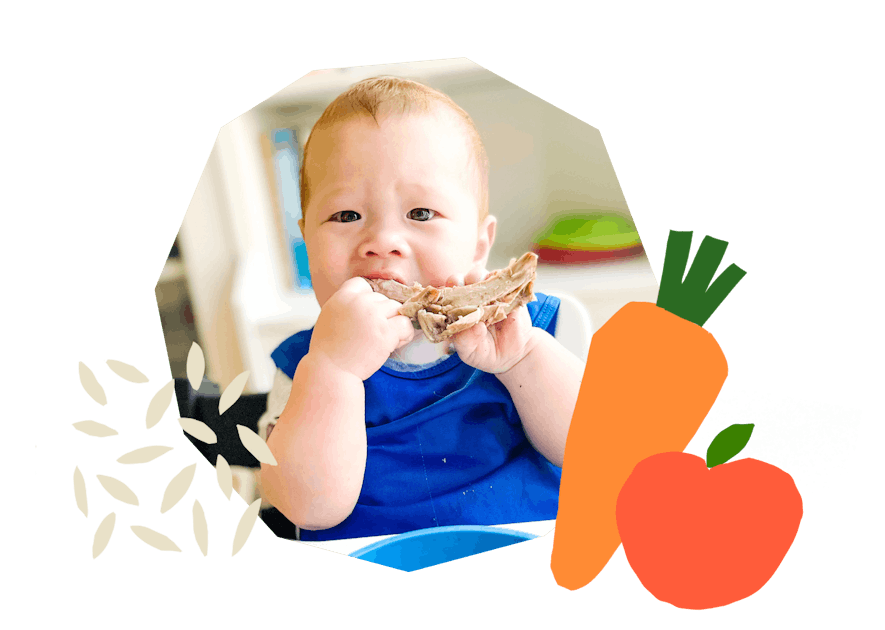
The Program Baby-Led Weaning with Katie Ferraro
A step-by-step digital program for starting solid foods safely and navigating the original 100 FIRST FOODS™ meal plan with baby-led weaning.
 EXPERT-LED, PROVEN APPROACH TO EATING REAL FOOD
EXPERT-LED, PROVEN APPROACH TO EATING REAL FOOD CONCISE VIDEO TRAININGS TO MASTER BABY-LED WEANING
CONCISE VIDEO TRAININGS TO MASTER BABY-LED WEANING 100 FIRST FOODS DAILY MEAL PLAN WITH FOOD PREP VIDEOS
100 FIRST FOODS DAILY MEAL PLAN WITH FOOD PREP VIDEOS
Baby-Led Weaning for Beginners Free Workshop
Is your baby ready to start solid foods, but you’re not sure where to start? Get ready to give your baby a solid foundation to a lifetime of loving real food…even if you’re feeling overwhelmed or confused about this next stage of infant feeding.
Get baby-led weaning recipes and tips delivered to your email inbox.



